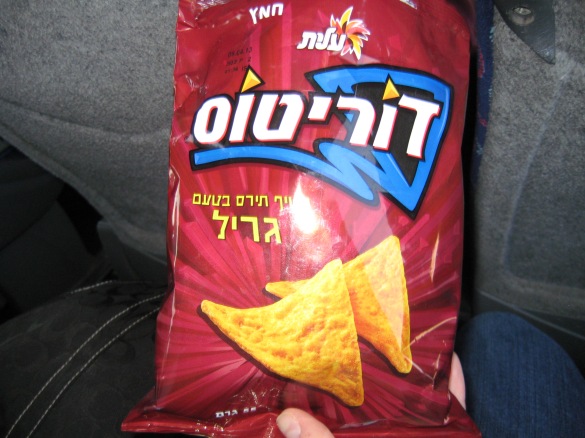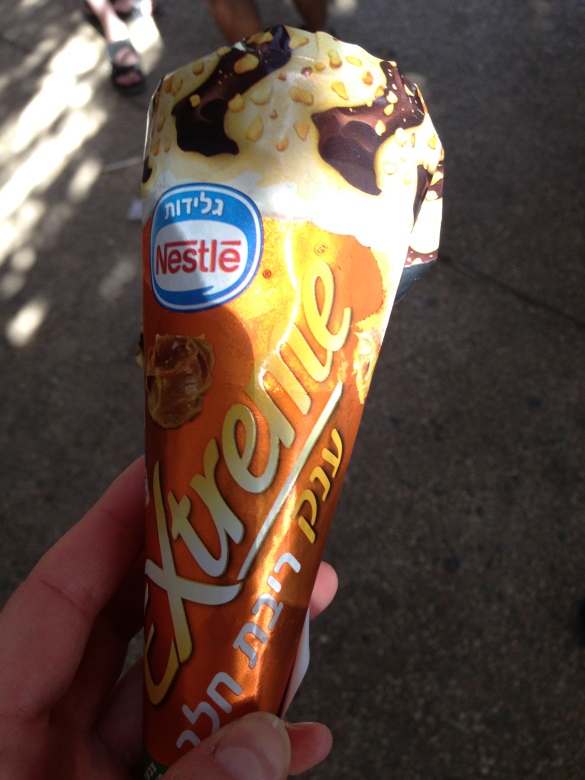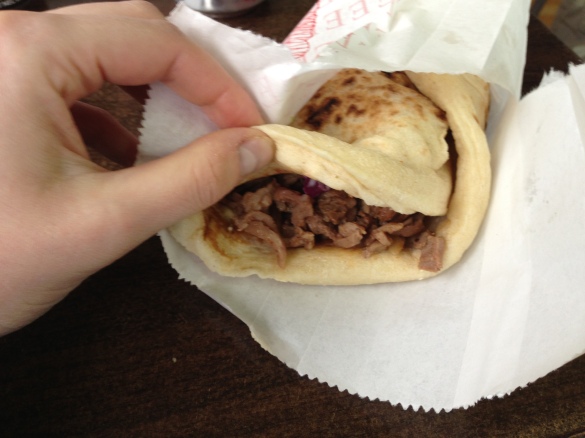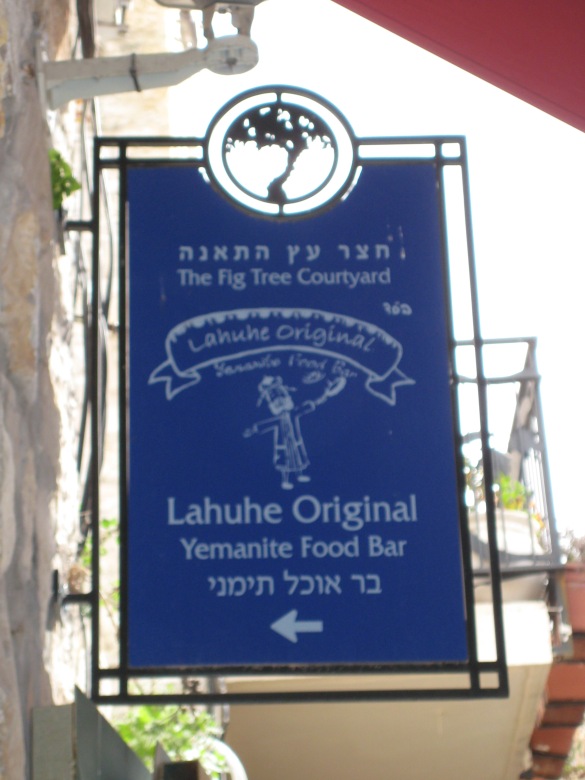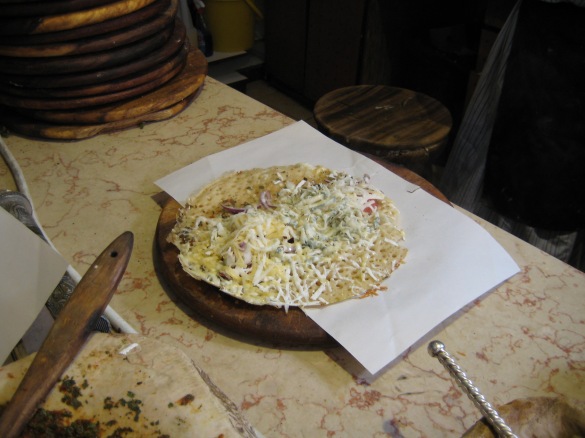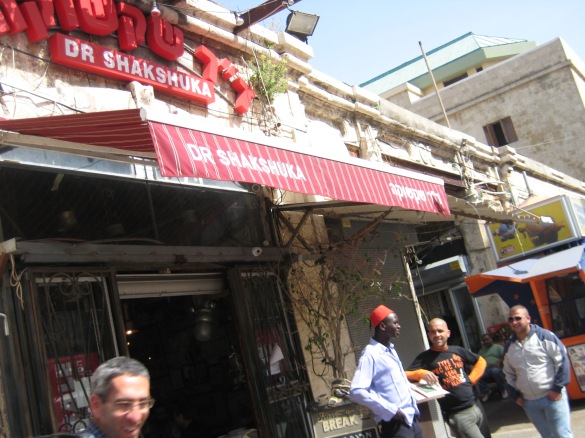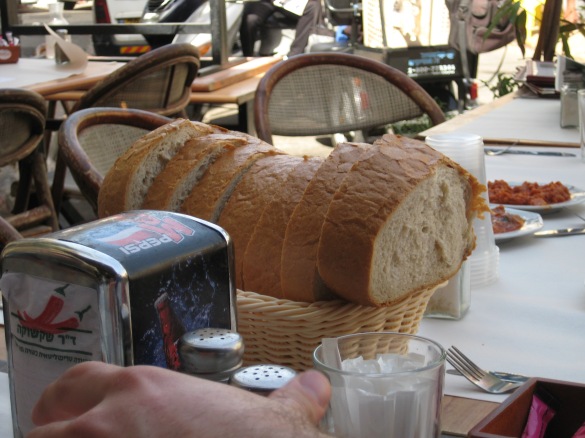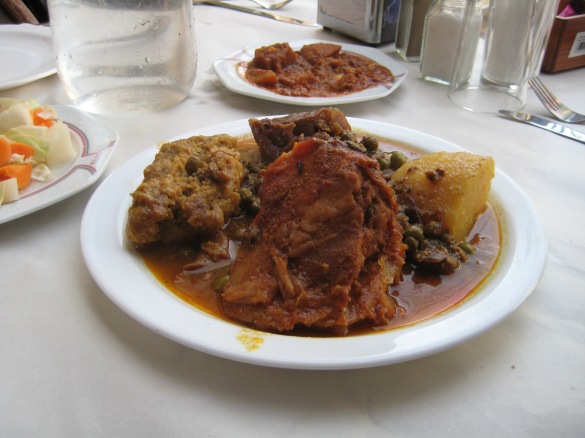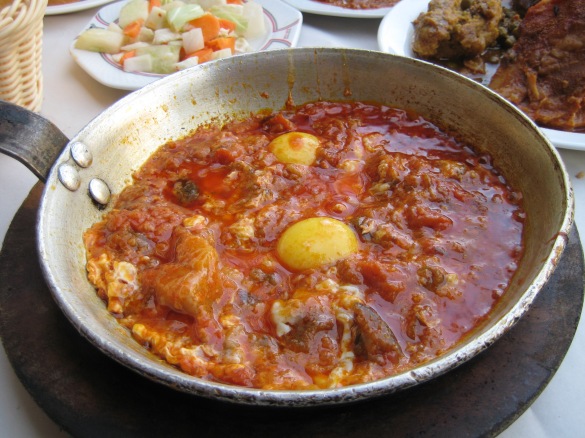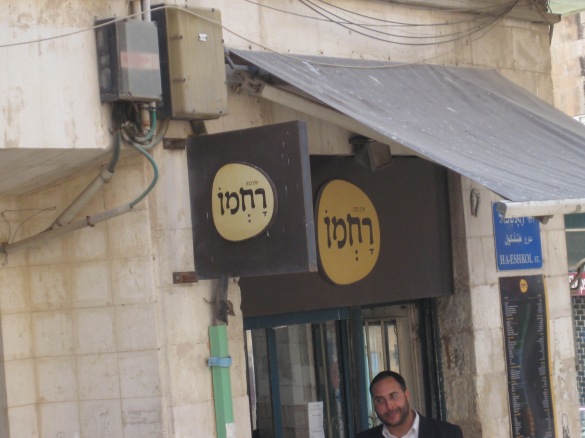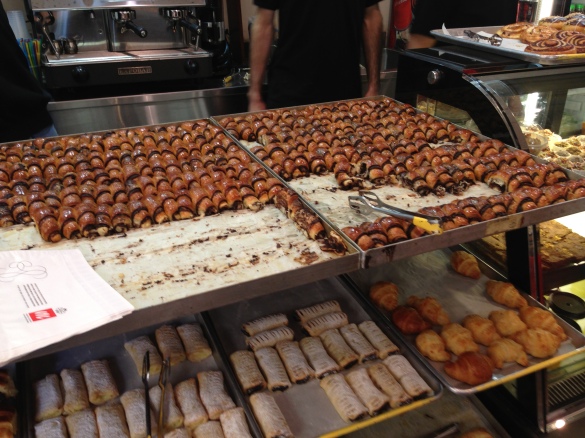While uploading photos to include in this last post about my trip to Israel, I suddenly realized how many different places I ate at. So I thought I’d include a quick montage of some of the more random and/or pedestrian fare I ate, and then focus on a few particularly memorable or exotic dishes from my travels.
We’ll start out with snacks — I’m sure that bag looks pretty familiar. It is the Israeli version of Doritos, and despite the non-Latin letters, the artificial cheesy flavor remains comfortingly the same.
Fans of Edgar Wright films may recognize this ice cream treat as Nestle’s Cornetto (http://en.wikipedia.org/wiki/The_Three_Flavours_Cornetto_Trilogy), frequently seen in American ice cream trucks as the King Cone. In Israel I saw a wider variety of flavors offered — this one featured peanuts and caramel, and was the perfect treat after a long hike up and down Masada.
Now onto the more local fare:
First up is the shawarma b’laffa I had in Sderot. My brother’s girlfriend Leah, who lived in Israel for a year, recommended that I get a laffa wrap at least once. Laffa is a larger flatbread, closer to naan in texture than a pita, and a million times better than your average wrap. The shawarma here was tasty, but one of my favorite things about your average street food/deli in Israel was the small salad and condiment bar that seemed standard. Even the mall shawarma place we stopped at one lunch had pan-fried eggplant, pickled vegetables, and a couple of different chunky sauces to accompany your meal. The meal I had in Sderot was memorable not because of the food itself, although it was delightfully greasy in the way a great sub from a NY deli is, but because of the significance of the location. Sderot is a border town with the Gaza Strip, and the poverty was pretty palpable. Our guide explained that due to the frequency of rocket attacks, all those who have enough money to leave Sderot have, and the people left are the ones that are stuck. This was great for our group because it meant a cheap lunch, but I couldn’t help but notice a certain haunted and worn-out look to the roads and market we walked through. There was another rocket strike only two days after we visited Sderot. Regardless of your feelings about the Israeli/Palestinian Conflict, there’s no reason innocent people (on either side) should be subjected to that kind of violence.
Let’s lighten up the mood a bit, and transition to a happier encounter with laffa. This small falafel shop was in a strip mall in Jerusalem. Tasty Falafel 4 offered 4 different types of falafel (wow, who could have made that intellectual leap?) with the option of putting it in a pita, laffa, or on a platter. They get extra points for all the different delivery options — half pita, half laffa, falafel, shawarma, a combo of the two, or veggies. They also gave you complementary “chips,” which were closer to the British chip in terms of being fried potatoes rather than our American Lays, but were actually small potato puffs that topped your order like a Greek gyro. I ended up getting a mix of all four falafel types with all the salad trimmings (except the spicy sauce). Sure, it was probably the equivalent of Taco Bell in NYC, but sometimes you just want fast food.
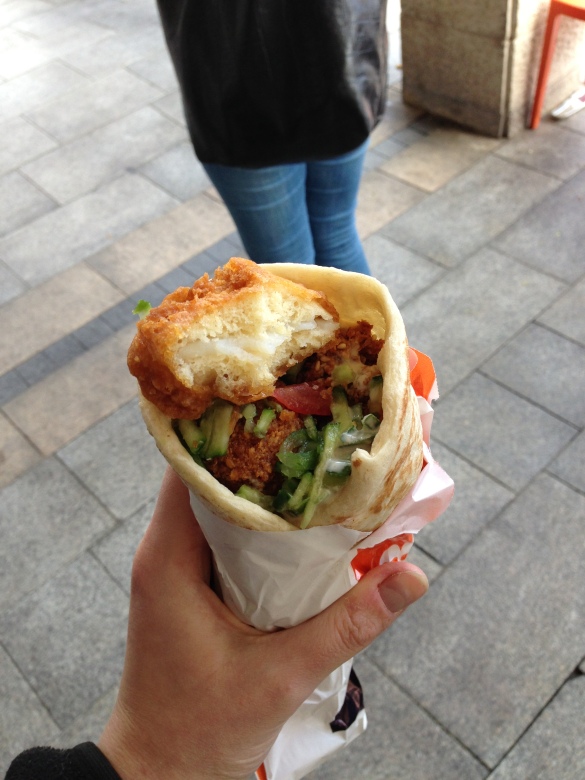
Sorry, but I couldn’t wait to bite into the “chip” on top before I took a picture of my falafel. Look at the soft potato center and golden brown fried edges. Mmm.
Next up, we have the Lahuhe from the sacred city of Tzfat. It’s basically a Yemeni crepe/burrito, full of herbs and spices and three different types of cheese.
I only tasted the wrap my friend Dave got, but it had the light texture of a tortilla mixed with gooey cheese and a heavy za’atar backend spice.
Let’s move into the big leagues for our next round of Middle Eastern edibles. I’ll admit that I had a list of must-try food written up before I even set foot on the plane (we’ve discussed my dependency on lists previously). A lot of the items on the list were types of food I had sampled in America, but I needed to compare with the more authentic Israeli equivalent — falafel, shawarma, hummus and so on. But at the top of the list was an elusive dish I have still yet to try in the US — shakshuka. Shakshuka is one of those foods that has a million variations across the globe — chak chouka, eggs in purgatory, huevos en el Purgatorio, and so on. At its most basic level, shakshuka is eggs poached in a spiced tomato sauce. When I told one of my Birthright leaders I was desperate to stick my face in some shakshuka, she suggested what seemed to be an obvious answer: go see the Doctor. Dr. Shakshuka, that is.
Dr. Shakshuka is a restaurant near the flea market in Jaffa, the older Arab city that Tel Aviv grew out of. The inside of the restaurant was crowded and dim, but around the corner Dr. Shakshuka has taken over the whole alleyway, ten tables of varying lengths strewn about the space. I ended up ordering family style with a bunch of my tripmates, getting shakshuka with eggplant, shakshuka with shawarma, stuffed peppers, and a couple of kebabs. The meal also comes with an unlimited supply of thickly sliced loaves of warm, soft white bread to sop up the runny egg and tomato sauce.
As I had hoped, Dr. Shakshuka totally lived up to expectations. The eggs were perfectly poached, and breaking the yolk led to the unctuous, fatty egg mixing with the acidity of the tomato. A self-professed eggplant zealot, I thought it was a great addition to the dish, the silky texture melding with the rest of the liquid, adding a little bit more chew without distracting from the spices. The beauty of the dish is the way everything comes together — this is definitely not one of those foods for people who like to keep each part of their dinner in separate little sections on their plate. You gotta be ready to get a little messy, dipping your bread in and keeping plenty of napkins at the ready. I know of a few places in NYC that serve shakshuka, and I’m eager to try them out — I only got to try the dish once in Israel, so no over-shakshuka-exposure for this gal.
The most exotic food I ate in Israel came on the last day of my trip, while strolling through Mahane Yehuda in Jerusalem. Another recommendation (both from the trip leaders and my brother’s girlfriend Leah) led me down a side street of the shuk to the Iraqi restaurant Rachmon.
Inside, the restaurant is visually nothing to shake a stick at. Small tables and rickety chairs fill the space, and you order off a menu on the wall, giving your order literally to one of the cooks, who makes and places your food on a cafeteria tray and sends you off to the elderly gentleman by the ancient cash register. I had zero knowledge of Iraqi food, but some items on the menu looked familiar — meat-stuffed cigars that seemed almost Greek, and those brimming bowls of hummus with different toppings of beans, vegetables, and sauces. But I couldn’t get just any ol’ bowl of hummus –I needed something authentically Iraqi (or at least ostensibly authentic). So I went with a bowl of red kubbeh. Kubbeh (or kibbe) is an overarching category of Middle Eastern dishes that involve bulgur or semolina and chopped meat. Red kubbeh is made up of semolina dumplings stuffed with ground beef, boiled in a tangy broth with stewed vegetables.
I initially thought the soup would be spicy, perhaps because I’ve been trained to equate “red” with curries or chili powders. But in fact it was more acidic than spicy, which played well against the richness of the dumpling dough and the ground beef. The vegetables were tender, and even with the meat the meal was filling, but not overly heavy. I know it’s pretty lame to get so excited about trying a new cuisine, but I was very pleased with myself for choosing something new and unknown. Luckily, I happened to like the food, too. There were a number of other kubbeh permutations to try at Rachmon, so I’m hoping I can find some Iraqi food in NY. One of my lunch buddies got fried kubbeh, which seemed almost empanada-ish in appearance.
We started with dessert, so we’ll end with it, too. Jaffa was especially kind to me, from the flea market where I found some great gifts, to Dr. Shakshuka‘s, and finally, to the best ice cream I had on my whole trip. Between his insatiable thirst for trivia and history, and his insatiable desire for ice cream, our tour guide Shachar was a man after my own heart (er, stomach?). He came along to Dr. Shakshuka for lunch, but barely touched his food, explaining that he was saving room for some phenomenal ice cream. And so after a little shopping in the market, I followed his directions to a gelateria a few blocks down. They had a wide assortment of flavors from sugarfree to fruit based to candy-laden types like Snickers. I opted to get a combination of the almond-toffee and the Indian Kulfi.
Overall, the milk base of the gelato was strong, but what really took my gelato to a new height were the flavors. The almond-toffee was delicious, if not particularly shocking — the crunch of the almond against the sticky, gooey toffee and the creaminess of the vanilla base was, as you would expect, a stellar combination. But the Indian Kulfi threw me for a loop. Cardamom was the dominant flavor, and I found it absolutely addictive. It reminded me of the best version of kheer, which is Indian rice pudding — almost savory in taste, but the creamy sugar sweetness of the gelato itself kept the flavor from veering out of dessertland. I’m “borrowing” my mother’s old ice cream maker this summer, and I’m determined to try to replicate this gelato. I’ve seen recipes for cardamom ice cream on sites like Serious Eats, and it’s definitely on the top of my ice cream experiments list.
Last, but not least, we’ll deal with one of those amazing food moments of redefinition. Sometimes all it takes is a really well-made version of a dish to completely shift your opinion. For me, this happened with rugelach. I’ve admitted in the past that I’m not the best Jew-food eater, and part of that was my distaste for rugelach. Too often I would come up against stale, dry, crusty rugelach, the filling like bland paste with the barest hints of the sweet promise of cinnamon or chocolate. Forget rugelach — hand me a piece of babka or a danish, please. But then I went to Marzipan Bakery in Jerusalem. Marzipan was a recommendation from the writers of Serious Eats, and with my rugelach-obsessed friend Zina in tow, when I caught a glimpse of the sign in the Jewish Quarter, I knew we had to stop in.
Inside, it was clear what their star product was:
And somehow, despite my history with disappointing rugelach, the fact that all of the city had switched to Kosher for Passover goods (blech, matzoh-meal), and the unreasonably high expectations. the rugelach I had from Marzipan that day was lifechanging. It was the best rugelach I’ve ever had — a slightly sticky coating on the toasted, flaky dough, a luscious chocolate filling that made me yearn for a Zabar’s babka. It was everything I’d been told I should love about rugelach, and damn if I wasn’t a proud Jew at that moment.
I’ll be honest, I’m wrestling with how to sum up this brief series of posts about my trip. I didn’t even get to all the delicious things I tried in Israel (like their fascinating take on frozen yogurt), but hopefully the items I’ve covered give a good picture of my general sense of wonder about the entire experience. This trip challenged me in so many ways, from traveling on my own (well, sans friends, that is) to getting up on a camel, to dipping my toes (and the rest of me) into the Dead Sea. Trying to capture just the part of the trip dealing with food keeps pushing me to make grander statements about my own personal growth and willingness to expand my palate, both for literal tastes and the larger tastes in my life. But truth be told, I’m backing away from the melodrama on this one. If you want a pitch for why everyone who can should do Birthright, let me know and I’m happy to jump right into the spiel. Mostly, I just had a wonderful vacation. And like most of the things I write about on this blog, it was as much about feeding my appetite as it was about feeding my curiosity.
